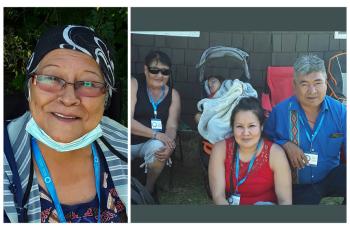Image Caption
Summary
Local Journalism Initiative Reporter
Windspeaker.com
Day school survivors Inez Jackson, from Goodfish Lake First Nation in northern Alberta, and Freddie Throassie, former chief of Black Lake First Nation in northern Saskatchewan, wish their parents could have been at Lac Ste. Anne on Tuesday in the presence of Pope Francis.
“My dad would have loved to hear this. My aunties and uncles would have loved to hear this on my dad’s side because they were really, really Catholic and they were in the Catholic schools,” said Jackson, 67.
“I feel my dad’s presence and my mom’s…My mom was a believer in Lac Ste. Anne. She believed in healing. And so did my dad.”
Jackson, who has been coming to Lac Ste. Anne for 40 years with her husband, is one of only two of her 15 siblings who makes the annual pilgrimage. Her older siblings attended residential school.
Jackson said they have found solace and strength in other spiritual ways.
As for the apology delivered by the Pope in Maskwacis on Monday, those siblings don’t accept it.
“They’re thinking this is not really an apology, but to me…listening to him, it was an apology. He apologized for the priests, for the schools. I swear I heard it in my heart that he did apologize, and I feel good,” said Jackson.
“It was very touching. Me and my husband watched him (on television) and we listened to him. It was very meaningful to us. I believe he spoke from his heart and he spoke for the churches and the residential schools.”
The value of an apology is something Jackson learned from her mother, Edith Memnook, who attended a residential school operated by the United Church.
In 1988, Memnook delivered the response on behalf of the All Native Circle Conference, acknowledging the apology issued by the United Church two years earlier.
“My mom got a lot of people mad for accepting the apology in the United Church, but it had to be done and my mom taught us not to live with this (anger) forever. We can’t. We have to forgive,” said Jackson.
As for her father, she said, by the time of his passing “he was at peace. He had forgiven the schools, priests, nuns… My dad went through lots—lots—at Catholic school.”
Throassie, 65, who made the trip from Black Lake First Nation with his wife, daughter, new grandson, and sister-in-law, said he’s attended the pilgrimage for five or six years.
“It means a lot to me, the Pope coming here into our gathering place. I just wish my mom and dad were here right now to witness all of this here,” he said.
“A lot of unfortunate things happen in our lives as First Nations people but we need to go on…We need to go forward so therefore that’s what I believe and I’m really fortunate to be part of this celebration.”
Throassie, who was “part of day school big time,” said he draws on his Catholic teachings and his faith in God for strength.
With the Pope’s apology, Throassie is confident that his grandson, Cadence, will be growing up in a different world. It will be a world that will include a connection to his traditions, his culture and his grandparents, a world that residential and day school survivors did not experience.
“Through me I want to teach him how it’s important, our culture, how we got here. That we’re a resilient people. We’re strong people. I’m going to teach him that,” said Throassie.
The value of grandparents and great grandparents, particularly grandmothers and great grandmothers, was a focus of the homily Pope Francis delivered at the prayer service held at the Lac Ste. Anne shrine yesterday. Saint Anne is the mother of Mary and grandmother of Jesus.
“Part of the painful legacy we are now confronting stems from the fact that Indigenous grandmothers were prevented from passing on the faith in their own languages and culture. That loss was certainly tragic. But your presence here is a testimony of resilience and a fresh start,” said the Holy Father. His words in Spanish were repeated in English by a priest.
The Pope touched on the “terrible effects of colonization, the indelible pain of so many families, parents, grandparents and children,” but never mentioned residential or day schools.
“We need healing from the temptation of closing in ourselves, of defending the institution rather than seeking the truth,” said Pope Francis.
He said to heal “effort, care and concrete actions on our part” were required.
He also spoke of building a “mother church” that would embrace everyone.
"Dear Indigenous brothers and sisters, I have come here as a pilgrim also to say to you how precious you are to me and to the church. I want the church to be intertwined with you, as tightly woven as the threads of the coloured bands that many of you wear,” said the Holy Father.
Pope Francis blessed Lac Ste. Anne and sprinkled water on the ground as he made his way from the lake to the shrine for the prayer service. He also blessed the statue Our Lady Undoer of Knots.
Lac Ste. Anne, or “Wakamne” as called by the Alexis Nakota Sioux meaning “God’s Lake,” has been a prominent spiritual gathering place for Indigenous people for the past 125 years.
The site was the final stop for the Pope in Alberta. On Wednesday morning, he boarded the plane for his two-day visit to Quebec. This afternoon there will be a welcome ceremony at Citadelle de Quebec. He will also be visiting with representatives of Indigenous peoples, Governor General Mary Simon and Prime Minister Justin Trudeau.
From Quebec, Pope Francis heads to Iqaluit. He will travel back to Rome on July 29.
Below there are photos by Windspeaker Media photographer Sandra Crowfoot.
Local Journalism Initiative Reporters are supported by a financial contribution made by the Government of Canada.

